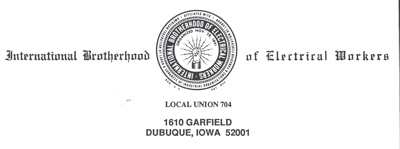Encyclopedia Dubuque
"Encyclopedia Dubuque is the online authority for all things Dubuque, written by the people who know the city best.”
Marshall Cohen—researcher and producer, CNN
Affiliated with the Local History Network of the State Historical Society of Iowa, and the Iowa Museum Association.
LOCAL UNION NO. 704
LOCAL UNION NO. 704. The union was founded in 1891, two years before George Westinghouse won the electric current wars by lighting the Chicago World's Columbian Exposition with alternating current and before homes and businesses in the United States had begun receiving electricity. It is an international organization, based on the principle of collective bargaining.
The beginnings of the IBEW were in the Electrical Wiremen and Linemen's Union No. 5221, founded in St. Louis, Missouri in 1890. By 1891, after sufficient interest was shown in a national union, a convention was held on November 21, 1891 in St. Louis. At the convention, the IBEW, then known as the National Brotherhood of Electrical Workers (NBEW), was officially formed. The American Federation of Labor gave the NBEW a charter as an AFL affiliate on December 7, 1891. The union's official journal, The Electrical Worker, was first published on January 15, 1893. It has been published ever since. At the 1899 convention in Pittsburgh, Pennsylvania, the union's name was officially changed to the International Brotherhood of Electrical Workers.
The union went through tough times in its early years, then struggled through six years of division during the 1910s, when two rival groups each claimed to be the duly elected leaders of the union. In 1919, as many employers were trying to drive unions out of the workplace through a national open shop campaign, the union agreed to form the Council on Industrial Relations, a body made up of equal numbers of management and union representatives with the power to resolve any collective bargaining disputes. That organization was still functioning in 2021, and largely resolved strikes in the IBEW's jurisdiction in the construction industry.
In September 1941, the National Apprenticeship Standards for the Electrical Construction Industry, a joint effort among the IBEW, the National Electrical Contractors Association, and the Federal Committee on Apprenticeship, were established. The IBEW added additional training programs and courses as needed to keep up with new technologies, including an industrial electronics course in 1959 and an industrial nuclear power course in 1966.
Today, the IBEW conducts apprenticeship programs for electricians, linemen, and VDV (voice, data, and video) installers (who install low-voltage wiring such as computer networks), in conjunction with the National Electrical Contractors Association, under the auspices of the National Joint Apprenticeship and Training Committee (NJATC), which allowed apprentices to "earn while you learn."
The IBEW's membership peaked in 1972 at approximately 1 million members. The membership numbers were in a slow decline throughout the rest of the 1970s and the 1980s before it stabilized. One major loss of membership for the IBEW came about because of the court-ordered breakup at the end of 1982 of AT&T, where the IBEW was heavily organized among both telephone workers and in AT&T's manufacturing facilities. Membership as of 2013 stood at about 750,000, according to their official website.
---
Source:
"International Brotherhood of Electrical Workers," Wikipedia. Online: https://en.wikipedia.org/wiki/International_Brotherhood_of_Electrical_Workers


